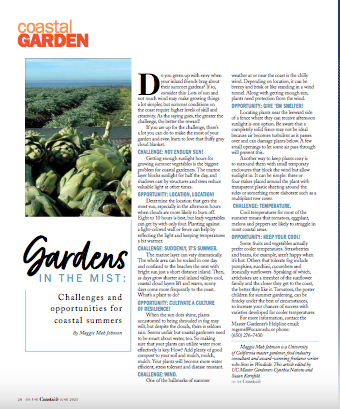Do you green up with envy when your inland-dwelling friends brag about their summer gardens? If so, consider this: lots of sun and not much wind may make growing things a lot simpler, but summer conditions on the coast require higher levels of skill and creativity. As the saying goes, the greater the challenge, the better the reward! If you are up for the challenge, there's a lot you can do to make the most of your garden and even learn to love that fluffy gray cloud blanket.
Challenge: Not enough sun!
Getting enough sunlight hours for growing summer vegetables is the biggest problem for coastal gardeners. The Marine Layer blocks sunlight for half the day and shadows cast by structures and trees reduce valuable light at other times.
Opportunity: Location, location!
Determine the location that gets the most sun, especially in the afternoon hours when clouds are more likely to burn off. 8-10 hours is best but leafy vegetables can get by with only 4. Planting against a light colored wall or fence can help by reflecting the light and keeping temperatures a bit warmer.
Challenge: Suddenly summer!
The Marine Layer can vary dramatically. The whole area can be socked in one day and confined to the beaches the next with bright sun just a short distance inland. Then, as days grow shorter and inland valleys cool, coastal cloud layers lift and warm, sunny days come more frequently to the coast. What's a plant to do?
Opportunity: Cultivate a culture of resilience!
When the sun does shine, plants accustomed to being shrouded in fog may wilt but despite the clouds, there is seldom rain. Seems unfair but coastal gardeners need to be smart about water, too. So making sure that your plants can utilize water most effectively is key. How? Add plenty of good compost to your soil and mulch, mulch, mulch! Your plants will become more water efficient, stress tolerant and disease resistant.
Challenge: Wind.
One of the hallmarks of summer weather at or near the coast is the chilly, wind. Depending on location, it can be breezy and brisk or like standing in a wind tunnel. Along with getting enough sun, plants need protection from the wind.
Opportunity: Give ‘em shelter!
Locating plants near the leeward side of a fence where they can receive afternoon sunlight is one option. Be aware that a completely solid fence may not be ideal because air becomes turbulent as it passes over and can damage plants below. A few small openings to let some air pass through will prevent this.
Another way to keep plants cozy: surround them with small temporary enclosures that block the wind but allow sunlight in. It can be simple: 3-4 stakes placed around the plant with transparent plastic sheeting around the sides or something more elaborate such as a multi-plant row cover.
Challenge: Temperature
Cool temperatures for most of the summer means that tomatoes, eggplant, melons and peppers are likely to struggle in most coastal areas.
Opportunity: Keep your cool
Some fruits and vegetables actually prefer cooler temperatures. Strawberries and beans, for example, aren't happy when it's hot. Others that tolerate fog include pumpkins, zucchini, cucumbers and ironically, sunflowers. Speaking of which, artichokes are a member of the sunflower family and the closer they get to the coast, the better they like it. Tomatoes, the poster children for summer gardening, can be finicky under the best of circumstances so increase your chances of success with varieties developed for cooler temperatures.
For more information, contact the Master Gardener's Helpline email: mgsmsf@ucanr.edu or phone: 650-276-7430
Maggie Mah Johnson is a UC Master Gardener, food industry consultant and award winning freelance writer who lives in Woodside, California. This article edited by UC Master Gardeners Cynthia Nations and Susan Kornfeld.
Attached Images:
